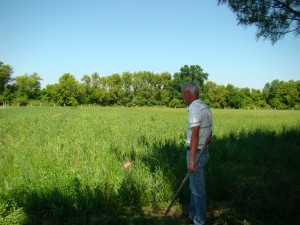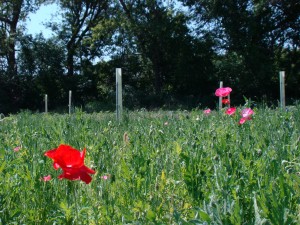Photographs continue to roll in from the field… and every one of them makes my day! Here are a couple shots of Wilson Tree Tubes in an oak savannah restoration project by a customer in Illinois.

A proud landowner looks out over his gorgeous prarie restoration project. You can wee the tree tubes in the distance. (Click to enlarge)

Beautiful! Looks like the customer has the "savannah" part of Oak Savannah well in hand. Wilson Tree Tubes are helping with the "Oak" part! (Click to enlarge - suitable for framing!)
Tree tubes are the perfect solution for oak savannah restoration. The oak in question is generally bur oak (Quercus macrocarpa) one of the world’s coolest and most under-planted trees. The naturalist writer Aldo Leopold said that bur oaks were “the shock troops sent by the invading forest to storm the prairie.” Their weapon in the fight against the sea of grass and wildflowers was fire. Bur oak is uniquely resistant to fire, with thick insulated corky bark and the ability as seedlings to resprout from the roots if the top is burned.
However in many cases we don’t have the ability to use fire in the same way that Nature (and indigenous people) did to favor the oaks. In many cases we have to accomplish the same thing in a different way. That means aggressively control the weeds around the bur oaks, either with herbicides or weed mats, along with mowing around them. And that means 1) being able to find your bur oaks amidst the see of grass and 2) protecting them from damage during weed control (while bur oaks stand up well to fire they are not as resistant to RoundUp or John Deere).
Speaking of deer, that is of course another reason why tree tubes are so integral to prairie restoration these days. In olden days with huge expanses of contiguous prairie (or, for that matter, contiguous expanses of forest) deer were few and far between. Deer are creatures of the forest edge. Our patchwork landscape has exponentially more forest edge than the pre- or early-settlement landscape did, making it ideal for deer. And therefore not so ideal for oak regeneration. What do you see in the background of these two photos? That’s right, edge. There’s simply no way bur oak seedlings planted along that edge are going to make it without tree tubes.
In the 23 years I have been working with tree tubes the most rewarding thing is seeing so many activities that were considered unusual or “fringe” activities – such as native plant restoration, prairie/savannah restoration, wildlife habitat restoration – become mainstream, with wonderful nurseries and skilled professionals providing the materials landowners need to make these great projects successful.
And of course it is immensely rewarding to play, via the tree tubes we offer, a small role in the success of those projects.
